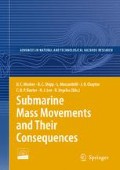Abstract
Within a GIS (geographical information system), spatial analysis techniques can be used to apply deterministic methods for identifying and mapping areas susceptible to shallow submarine mass movements. This paper describes such a method which allows spatially widespread, rapid, repeatable and cost-effective evaluation of shallow submarine slope risk. A deterministic approach has the advantage of providing a quantitative output; useful in subsequent project risk assessment. The use of GIS in this way is well established. Many of the method limitations described in the literature can now be overcome. This paper describes some advances through which these limitations are being addressed, and the compromises that still need to be made. The paper places emphasis on GIS modeling of the full three-dimensional variation of geotechnical input parameters. This approach allows the type of sophisticated ground model now becoming available from regional engineering geological and geohazard studies to be harnessed and exploited. The approach described in the paper has been applied on deepwater oil and gas projects having development areas of over 1,000 km2.
Access this chapter
Tax calculation will be finalised at checkout
Purchases are for personal use only
References
Campbell KJ (1984) Predicting offshore soil conditions. Proc Offshore Technol Conf, Houston, Texas.
Dai FC, Lee CF (2001) Terrain-Based Mapping of Landslide Susceptibility using a Geographical Information System: a Case Study. Can Geotech J 38:911–923.
Evans T, Usher N, Moore R (2007) Management of Geotechnical and Geohazard Risks in the West Nile Delta. Proceed 6th Intern Offshore Site Investigation and Geotechnics Conf: Confronting New Challenges and Sharing Knowledge, Soc Underwater Technol, Lond.
Graham J (1984) Methods of Slope Stability Analysis. In: Brunsden D, Prior DB (Eds) Slope Instability, Wiley, New York, pp. 171–215.
Hitchcock C, Givler R, Angell M, Hooper JR (2006) A Pilot Study for Regionally-Consistent Hazard Susceptibility Mapping of Submarine Mudslides. OTC 18323, Proc Offshore Technol Conf, Houston, Texas.
Hooper JR, Prior DB (1989) Regional Analysis of Slope Stability for Deepwater Engineering. Oceans 09, sponsored by the Mar Technol Soc & Oceanic Eng Soc IEEE 5:1536–1540.
Jeanjean P, Liedtke E, Clukey E, Hampson K, Evans T (2005) An Operator's Perspective on Offshore Risk Assessment and Geotechnical Design in Geohazard-Prone Areas. Frontiers in Offshore Geotech: ISFOG 2005.
Kvalstad T, Gauer P, Kayina AM, Nadim F, Bryn P (2002) Slope Stability at Ormen Lange. Conference Proc Offshore Site Investigation and Geotechnics: Diversity and Sustainability, Soc Underwater Technol, Lond.
Nadim F, Krunic D, Jeanjean P (2003) Probabilistic Slope Stability Analyses of the Sigsbee Escarpment. OTC 15203, Proc Offshore Technol Conf, Houston, Texas.
Orren R, Hamilton I (1998) Frontier Geohazard Site Investigations — Experiences from the Caspian Sea. Offshore Site Investigation and Foundation Behaviour: New Frontiers, Soc Underwater Technol, Lond.
Soeters R, Van Westen CJ (1996) Slope Instability Recognition, Analysis, and Zonation. Landslides: Investigation and Mitigation, NERC Transportation Res Board Spec Rep 247:129–177.
Thomas S, Hooper JR, Clare M (2009) Constraining Submarine Geohazards to the Past: A Conceptual Review of the Assessment of the Potential Impact of Submarine Mass Movements on the Planning of Seabed Developments. Proc 4th Intern Symp on Submari Mass Movements and their Consequences, Austin, Texas.
Van Westen CJ, Rengers N, Terlien MTJ, Soeters R (1997) Prediction of the Occurrence of Slope Instability Phenomena through GIS-Based Hazard Zonation. Geologische Rundschau 86:404–414.
Wu W, Sidle R (1995) A Distributed Slope Stability Model for Steep Forested Basins. Water Resour Res 31:2097–2110.
Xie M, Esaki T, Zhou G, Mitani Y (2003) Geographical Information Systems-Based Three-Dimensional Critical Slope Stability Analysis and Landslide Hazard Assessment. J Geotech Geoenviron Eng 129:1109–1118.
Acknowledgments
The authors acknowledge the valuable opportunities and input given by individuals from external organizations over the years, and the assistance and discussion provided by colleagues in the Fugro Group, together which have enabled the production of this manuscript.
Author information
Authors and Affiliations
Corresponding author
Editor information
Editors and Affiliations
Rights and permissions
Copyright information
© 2010 Springer Science+Business Media B.V.
About this chapter
Cite this chapter
Mackenzie, B., Hooper, J., Rushton, D. (2010). Spatial Analysis of Shallow Slope Instability Incorporating an Engineering Geological Ground Model. In: Mosher, D.C., et al. Submarine Mass Movements and Their Consequences. Advances in Natural and Technological Hazards Research, vol 28. Springer, Dordrecht. https://doi.org/10.1007/978-90-481-3071-9_30
Download citation
DOI: https://doi.org/10.1007/978-90-481-3071-9_30
Publisher Name: Springer, Dordrecht
Print ISBN: 978-90-481-3070-2
Online ISBN: 978-90-481-3071-9
eBook Packages: Earth and Environmental ScienceEarth and Environmental Science (R0)

